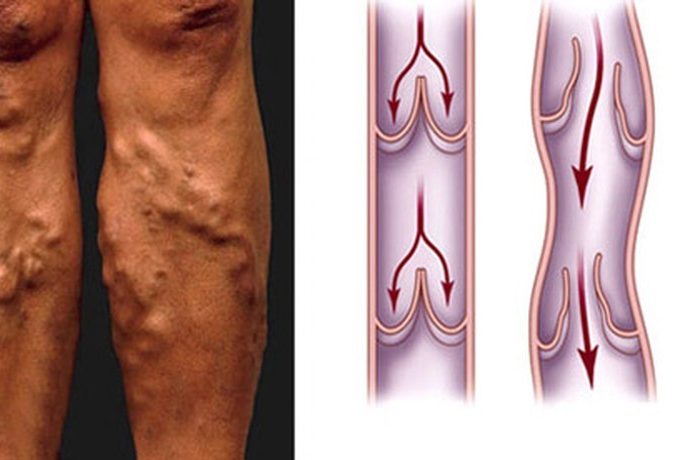
CHRONIC VENOUS INSUFFICIENCY (CVI) – THINGS TO REMEMBER
WHAT IS VENOUS INSUFFICIENCY?
- Varicose veins of the lower extremities:
- This is a dilation, cylindrical extension, with the development of tortuous veins, which is visible under the skin of the lower extremities.
- Chronic venous insufficiency:
- This is the impaired function of the lower limb vein system owing to venous valve failure.
- This condition makes blood stagnant inside the veins and difficult to return to the heart.

RISK FACTORS:
People who have each of following factors might take a higher risk of suffering from CVI:
- Increasing age and female sex
- Standing or sitting for a long time, working in hot environments, carrying heavy objects
- Obesity
- Pregnancy
- Family history of venous disease
CLINICAL SYMPTOMS:
Varicose veins can be detected through symptoms such as:
- Localized pain, limb swelling
- Feeling of heavy, numbness, burning in the legs
- Legs cramping at night
- Veins are visible under the legs skin.
Those symptoms are worsened by extended periods of standing or sitting and relieved by raising of the legs or wearing compression stockings.
DIAGNOSTICS:
- Based on clinical examination which is mentioned above.
- Also, imaging are used to help diagnosis:
- Venous Doppler ultrasound, which is the most important test
- Venography
- CT venography, in order to review the anatomy of the veins
- MRI venography
LEVELS OF SEVERITY:
- C0: No visible or palpable signs of venous disease;
- C1: Varicose or reticular veins, with a diameter of <3mm;
- C2: Varicose veins, with a diameter of ≥ 3mm;
- C3: Lower extremity edema, no skin changes;
- C4: Dystrophy of the skin with changes in skin and subcutaneous tissue;
- C5: Skin changes described above with the healed venous ulcer;
- C6: Skin changes outlined above with an active ulcer
COMPLICATIONS:
If CVI is not treated, patients might face up with following complications:
- Thrombophlebitis: redness, swelling, heat, prominent of superficial veins and induration;
- Venous thromboembolism: the formation of blood clots inside the veins, which leads to the pulmonary embolism;
- Ulcers: circulatory stagnation and nutritional disorders of the lower extremities cause ulcers, which are difficult to treat.
TREATMENT:
- Change habits:
- Avoid long periods of standing or sitting.
- Playing sports, doing exercises.
- Frequent elevation of your legs.
- Compression therapy with compression stockings,
- Compression bandage
- Drugs therapy:
- Drugs, which help stabilize the vessel walls, such as:
- Daflon
- Rutin C
- Venosan
- Interventional therapies:
- Sclerotherapy: Applied to tiny and local varicose veins
- Endovenous thermal ablation: using high-frequency wave or laser to treat varicose veins, less pain, quickly recover and ensure aesthetics, instead of applying the classic varicose surgery
- Surgery: to remove dilated venous tufts, varicose veins, repair the valve,
SOME FALSE BELIEFS:
However, there are still some false beliefs about this disease:
- Varicose veins patients should avoid walking?
This one is a false belief.
Walking is not only good for the cardiovascular system but also helps to lose weight and prevent obesity. The walking movement helps the legs muscle contract. So, they can put the pressure on the deep veins, in order to pump blood back to the heart more efficiently. As a result, the symptoms of pain and discomfort might be relieved.
Thus, varicose veins patients should walk, should not sit for too long
- Varicose veins patients should not elevate their legs?
This one is such a false belief, too.
When you go to bed, you should elevate your feet at about 15-20cm higher than the heart level to help blood return to the heart more easily.
- Varicose veins patients should soak their feet with hot water every day?
This is a false belief.
Hot water dilates the veins, the veins become more dilated and tend to worsen the symptoms of the disease. Therefore, do not soak feet in hot water.
- All sports are good for varicose vein patients?
This one is false, too.
Sports like soccer, tennis, volleyball, high jump, long jump … do not benefit the veins because it affects the veins when we run at high speed and intensity.
Sports such as swimming, walking, dancing, and cycling are recommended. Because those sports help people raise heels and improve the movement of their ankle joints and calf muscles.
REFERENCES
1. Eberhard Rabe et al (2016). Epidemiology of chronic venous diseases. Wiener Medizinische Wochenschrift volume 166, pages 260–263
2. Nguyen Thi Hai Yen. Chronic venous insufficiency is a lesser known cause of death.
Source:Phan Thai Hao, Second degree specialist, MSc , Polyclinic of Pham Ngoc Thach university of medicine